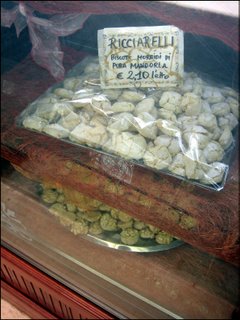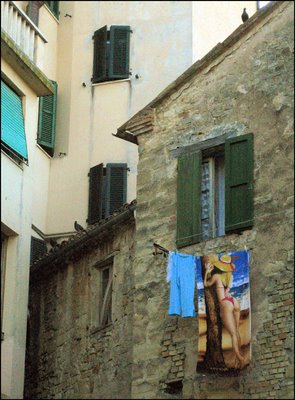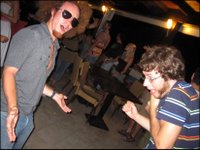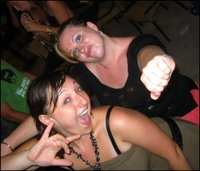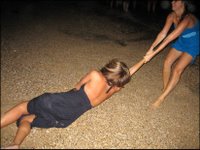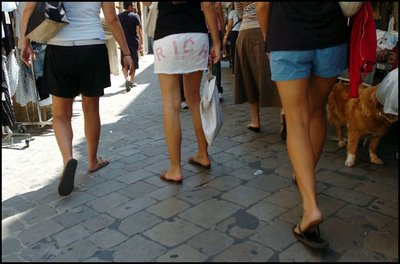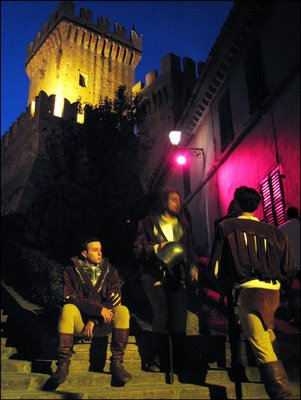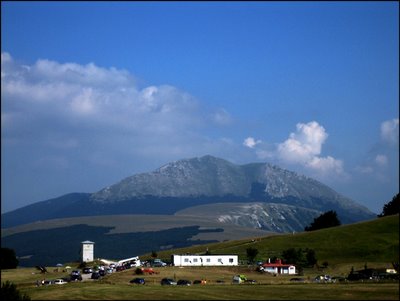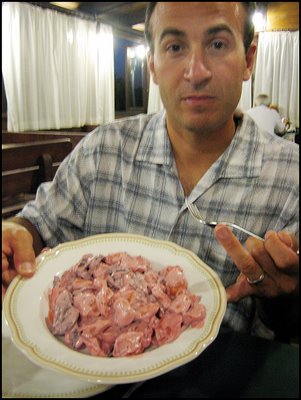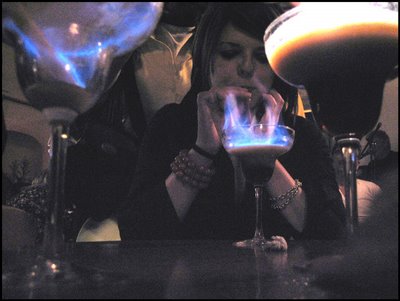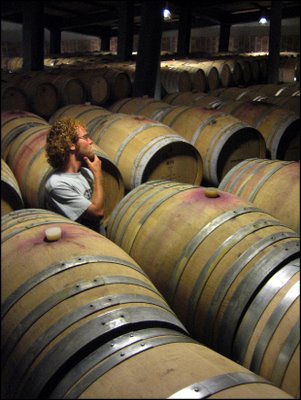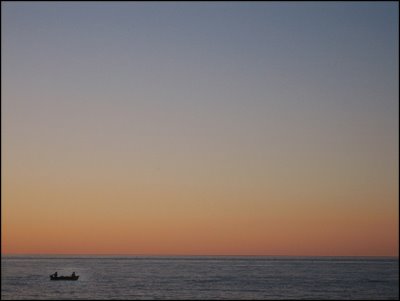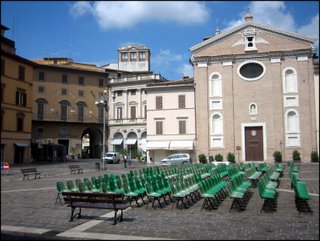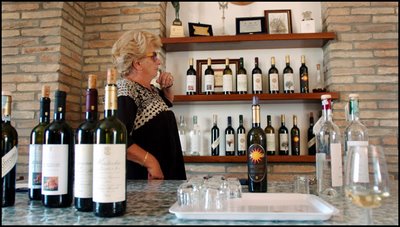
EDITOR'S NOTE: This entry comes to us from Alyssa Porambo, a blonde member of the 2006 Cagli Project.
EVER SINCE I WAS FIVE, I have had blonde hair. Long, straight golden locks have been my trademark look for so long that sometimes I am unaware of my dominant physical attribute. Many people in the States have blonde hair, and so I usually slip into the crowd as just another flaxen girl.
In the small town of Cagli, Italy, on the other hand, it is a completely different story.
I have never been so aware of my blondeness since staying in Cagli for one month.
Cagli is composed almost entirely of brunettes.
As I walked through the streets of the old town the day I arrived, I was much too excited to notice anything besides the beautiful stone buildings and the charm of the people. After a few days, however, I began to notice how few blondes I saw strolling around the piazza.
Eventually, I push back the questions I have about blondes in Cagli, thinking they are all in my head. Still, at the halfway mark of my stay in Italy, I had yet to meet a blonde Cagliese.
Are Italians from this region not naturally blonde? Why had I not seen a woman even with bright blonde highlights? Is being blonde not popular? It did not seem that way to me because every time I went out with my friends, the Italian men would ask to have their picture taken with me. Some of them would just stare at my hair in awe, and some would even come up to me and begin stroking my hair, reminding me of a childhood occurrence.
Picture this: I am sitting on a train in Florence with my parents and my younger brother. I am eight years old. An older Italian woman walks in my direction, stops, and stares at my head. She begins moving slowly towards me and finally, there she is, standing in front of me.
Unsure of what to do, I look to my mom for some guidance but she is just as confused as I am. Suddenly, I feel a hand on my head, moving back and forth. It is at this moment I realize that the woman is stroking my hair, intensely examining it. She’s smiling at me, repeating the phrase “Che bella! Che bella!” over and over.
Soon, everyone in the train is staring in our general direction, looking for the source of great joy for this woman. She then bent down, pinched my cheeks, and said, “Bella Americana!”
Then she just walked away, leaving a very confused eight-year-old girl to wonder what the heck just happened.
My family had moved to Germany to live for three years when I was seven years old. Throughout our time in Europe, we traveled extensively: France, Austria, Switzerland, the Czech Republic, Poland, Germany and Italy. Every new place we went, the natives had different reactions to my hair color.
In Austria, for instance, I was never looked at as different or strange; I blended into the crowd nicely. In France, I was clearly American, but there was no overwhelming reaction to my appearance.
The Italian people, however, opened my eyes to the great distinction between blonde and brunette. The incident on the train was my first encounter with a reaction of astonishment to my hair color but it was not the last.
We traveled to Italy three times while living in Germany, and every time we went, I would be pointed at, smiled at, and gawked at. As a 10-year-old walking the streets of Rome with my mom, an old woman grabbed my hand and pulled me down so she could touch my hair.
“What the heck is it with these Italians and loving blonde Americans?” I would wonder to myself every time I would be pointed at, stared at.
As a 17-year-old, I returned to Italy with a group of friends. My friend Kelsey and I were the only two blonde girls on the trip. Similar to my experiences as a child, we received a multitude of looks from Italians, but this time, it was not from cute Italian grandmothers.
This time, they came from Italian men, believing that being blonde had a much different connotation than “Hi, I’m American, come and pet my head, please.”
We would not even have to open our mouths and speak English for them to realize we were American, flock over and begin talking to us in Italian.
So when I found out I was returning to Italy in the summer of 2006, I prepared myself for the worst. I expected men to flock to me, women to point at me, and children to look at me like I had three heads.
And boy was I right.

Shouts of, “Americana! Americana!” could be heard throughout the main piazza in Cagli the moment I stepped off that bus. And they have continued throughout my time here.
It is as if these people have not seen a blonde woman in their lives! Is it really that rare to see a blonde in this town? Italian magazines and Italian television are both saturated with blonde women. Is it not the same to see a blonde woman in a picture as to see one in real life?
When I finally meet a blonde woman in Cagli, I am so excited! But then I learn that she is originally from Bulgaria and moved to Cagli when she got married.
“There are no blondes in Cagli,” she says as she shakes her head. “I am convinced!”
Suddenly, it became my mission to find at least one blonde native Cagliese before I returned to the States. There has to be at least one blonde Italian roaming around here somewhere!
However, my quest turns out to be much more difficult than I had expected. Every baby, teenager, and woman I came across ss brunette. Even when I go to the local grocery store, Sidis, I can find no hair care products for blondes. As I hopefully scan the shelves for any sign of blonde life in Cagli, I conclude that it is nowhere to be found.
When I spoke to one of the local hairdressers about blondes, Matteo Susini, he informed me of the reasons why there is a great lack of flaxen girls in this region of Italy.
“Most of the blondes come from northern, not Central Italy,” he says. “It is very rare to see a natural blonde walking through the streets of Cagli because most people from this region are dark haired.”
“Also, women here do not want to be dyed blonde because it takes too much maintenance,” Matteo, a blonde, continues. “Blonde highlights are more popular because of the minimal upkeep.”
Finally, armed with the reasons why there are few blonde women in the town of Cagli, I take to the ancient streets holding my head up high.
I am one of very few in this town who dares to sport light locks and darn it, I will embrace it.
Being blonde in a brunette city was strange for me at first, but I now embrace my ability to make a sad man happy with a flick of my neck, the toss of my hair and a smile on my face.
I am an American. I am a blonde. And I am so proud.
- Alyssa Porambo
acporambo@loyola.edu
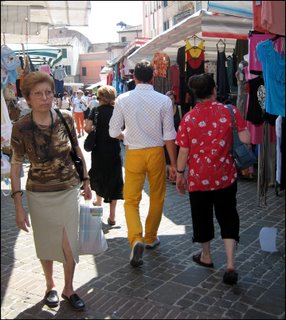 THE TREND FOR men is yellow pants.
THE TREND FOR men is yellow pants. 